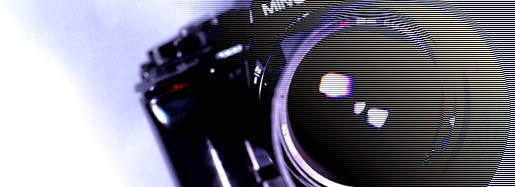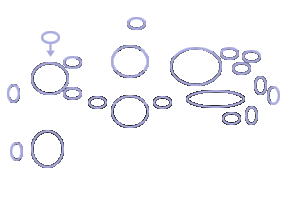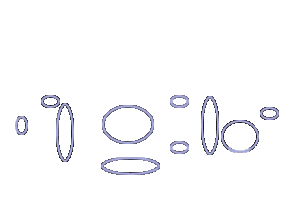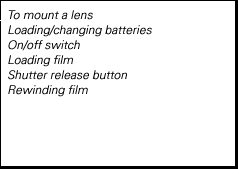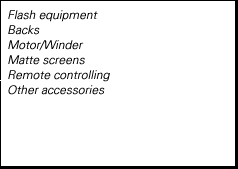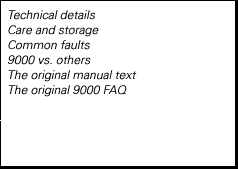9000 vs. others
Should I buy a used 9000, with its old technology, or should I buy a newer camera? This document tries to outline advantages and disadvantages with either approach.
9000 vs. a newer beginner-class camera
Most of the time when starting out in "serious" photography and buying a SLR (Single Lens Reflex) camera, one thinks of buying a cheap bottom-of-the-line camera. Examples are Canon's x00- and x000-class (i.e. EOS 300, EOS 5000), Minolta's 5-class (i.e. 505si, Dynax 5), or Nikon's or Pentax' equivalent models. What they may offer is:
- Significantly faster autofocus systems.
The 9000's autofocus is slow, outperformed by almost every other camera made after 1985, spare the Nikon 401 and 501 models. - "Better" light metering.
Newer cameras have multi-segment meters, which evaluate the scene and tries to expose according to certain rules. The 9000 has but only two metering systems, center-weighted metering and spot metering. Center-weighted metering is good after some practice, but will "miss" more often in snapshot situations than a modern multi-segment system; spot metering is extremely adequate when used right, but takes time to master and use. - Better flash control.
A new camera may have a more reliable flash light meter, and/or flash compensation so you can control the light yourself. The 9000 lacks both. - Motor drive.
The 9000 is the only SLR with integrated AF ever made that lacks a motorized wind function. - Built-in flash.
The 9000 requires an external flash. - Control wheels.
The 9000 uses levers to operate the settings. The wheel type controls featured on all modern cameras are much faster and better in every way (except that they may break more easily). - Better servicing odds.
The 9000, being an old camera, may be without luck if it breaks; spare parts are getting more and more scarce. In ten years, can you still get it serviced?
So what may the 9000 offer that the cameras above cannot?
- Heavy-duty construction.
A 9000 will take some amount of beating before it gets killed. A modern bottom-of-the-line camera won't. - Fast shutter speeds.
The 9000 has 1/4000 sec. as its fastest shutter speed, and more important, it has 1/250 as flash sync speed. This is important for daylight fill flash, among other things. - Manual wind/rewind.
This is not only a disadvantage, but in many cases more of an advantage. In quiet settings the "slap" of the 9000's mirror is less obtrusive than the slap-wheeeee sound of a motorized camera. Even more irritating is the rewind noise when a roll is finished if the modern camera is set to auto rewind. Naturally, the rewinding operation of the 9000 is completely quiet. The 9000 can save your wedding/baptism/theater photo opportunity. - Small size. Even though there are smaller cameras, the 9000 is very modest in its size -- at least much more discrete than every other pro-class SLR camera I know of.
- No-nonsense operation/interface.
The 9000 is very easy to work with. If you have ever used an SLR before, everything will be easy to figure out. If you never have, it's an easy camera to learn. - The ability to use MD-90.
The motor drive MD-90 can shoot with 5-6 frames per second, much more than any bottom-of-the-line camera. - The ability to use Program Back Super 90.
This back is still the most advanced program back in existence, with unique features if you're into interval shooting, modifying program curves, data imprinting, and so on. - Powered by AA batteries.
Cheap batteries which you can find everywhere. And the camera doesn't consume much power, either, especially if you don't use the autofocus. - Many other niceties not available on many other cameras.
DOF preview, built-in diopter correction for near/far-sighted operators, built-in viewfinder blind, and an AF/MF-switch that stays where you put it (unlike a couple of other Minolta models). - Inexpensive, especially if you don't need the motor.
9000 vs. a newer "advanced amateur"-class camera
Examples of these cameras are Pentax MZ-5 and SFX, Minolta 7-class (i.e. Dynax 7 and 700si), Canon x0-class (i.e. EOS 10, EOS30), and Nikon 6-8-class (i.e. F601, F80).
This is a hard one. Of course, all advantages for the bottom-of-the-line cameras advantage list also applies here -- but some of the 9000 advantages are lost in comparison, or overshadowed by other useful features on the newer cameras. The main reasons for choosing a 9000 over those other cameras would be the manual wind/rewind and the construction of the camera. The 9000 has a real spot meter, too. A wildlife/nature photographer on a budget will probably love the 9000.
9000 vs. a newer pro-class camera
Examples of these cameras are Pentax MZ-S, Minolta 9-class (i.e. Dynax 9 and 9xi), Canon x-class (i.e. EOS 1, EOS3), and Nikon Fx-class (i.e. F4, F5).
Here almost all advantages for the 9000 are negated. We still have the manual winding and rewinding, but F4 and F5 has manual rewind; all other cameras in this class are built to last; and they all have vertical grips and motor speed to match the 9000. Reasons for choosing a 9000 are:
- As a backup camera within the Minolta system.
You already own other Minolta cameras, and want access to a tough camera as a backup or for special occasions. - Program Back Super 90.
Want access to some of the features of this program back? Intervalometer? Multi-spot metering? Data imprinting? This back on a 9000 offers everything in a nice package at a very reasonable price level. - Size and weight.
Both are comparably low. - Price.
The 9000 is extremely inexpensive in comparison with other professional cameras from the same era. In fact, you can buy two or three for the price of just one used Nikon F4!
9000 vs. manual cameras
The 9000 may well be the best manual camera Minolta ever made. Just disengage the autofocus, and you have a sturdy, highly usable camera for manual work. It features both center-weighted and spot metering, it has all four exposure modes (P, A, S, M), and it has a standard flash shoe and a PC-sync contact. The only problems is that it has no mirror lock-up, is not usable without batteries (but take a spare set of AA batteries and get one more month of heavy usage) and thus has no mechanical times, and that it takes Minolta AF lenses not originally made for manual work. However, you may outfit it with a MD-to-AF-adapter and thus use your old Minolta MC/MD lenses on it, or you may even buy an inexpensive M42 adapter to use your old 42mm thread-mounted lenses (i.e. from the Pentax Spotmatic era). As the light metering isn't tied to the AF system as in later Minolta cameras, the 9000 will happily give you correct exposure -- even TTL flash control! -- whichever lens you may manage to put in front of it.

